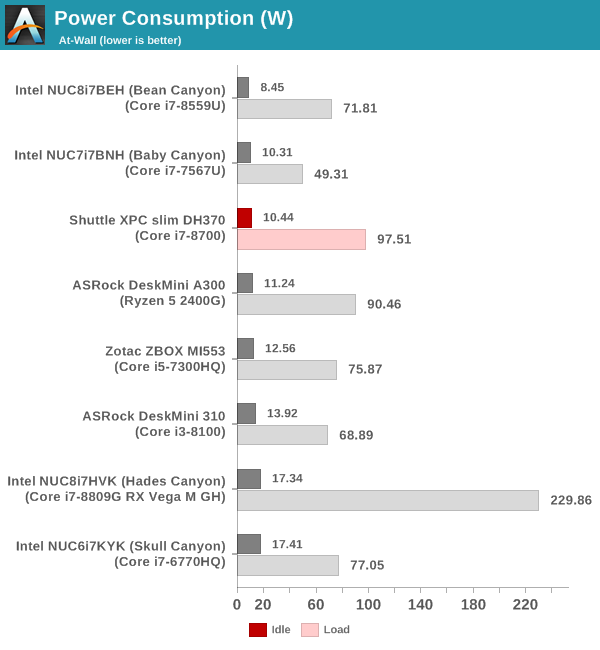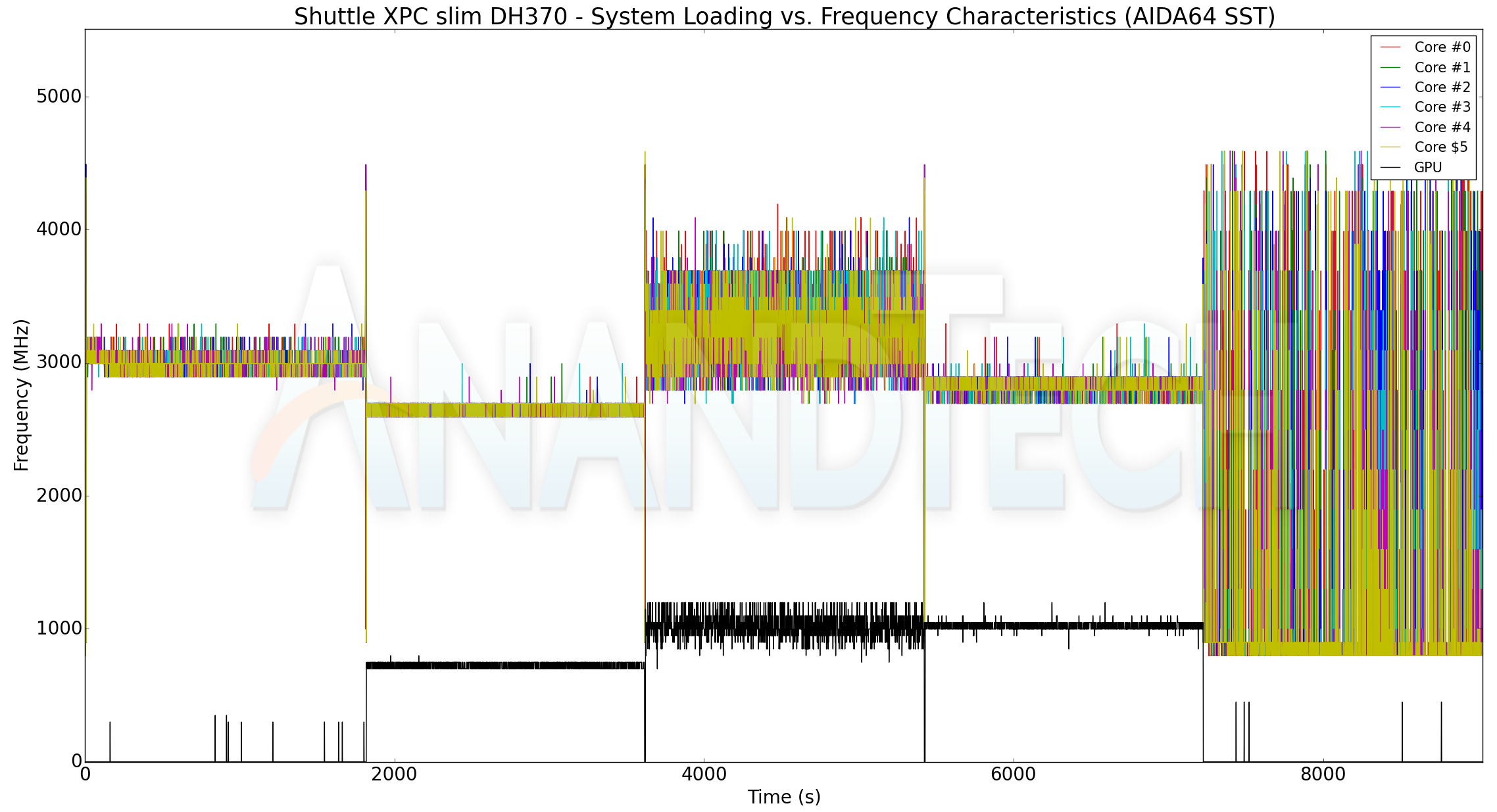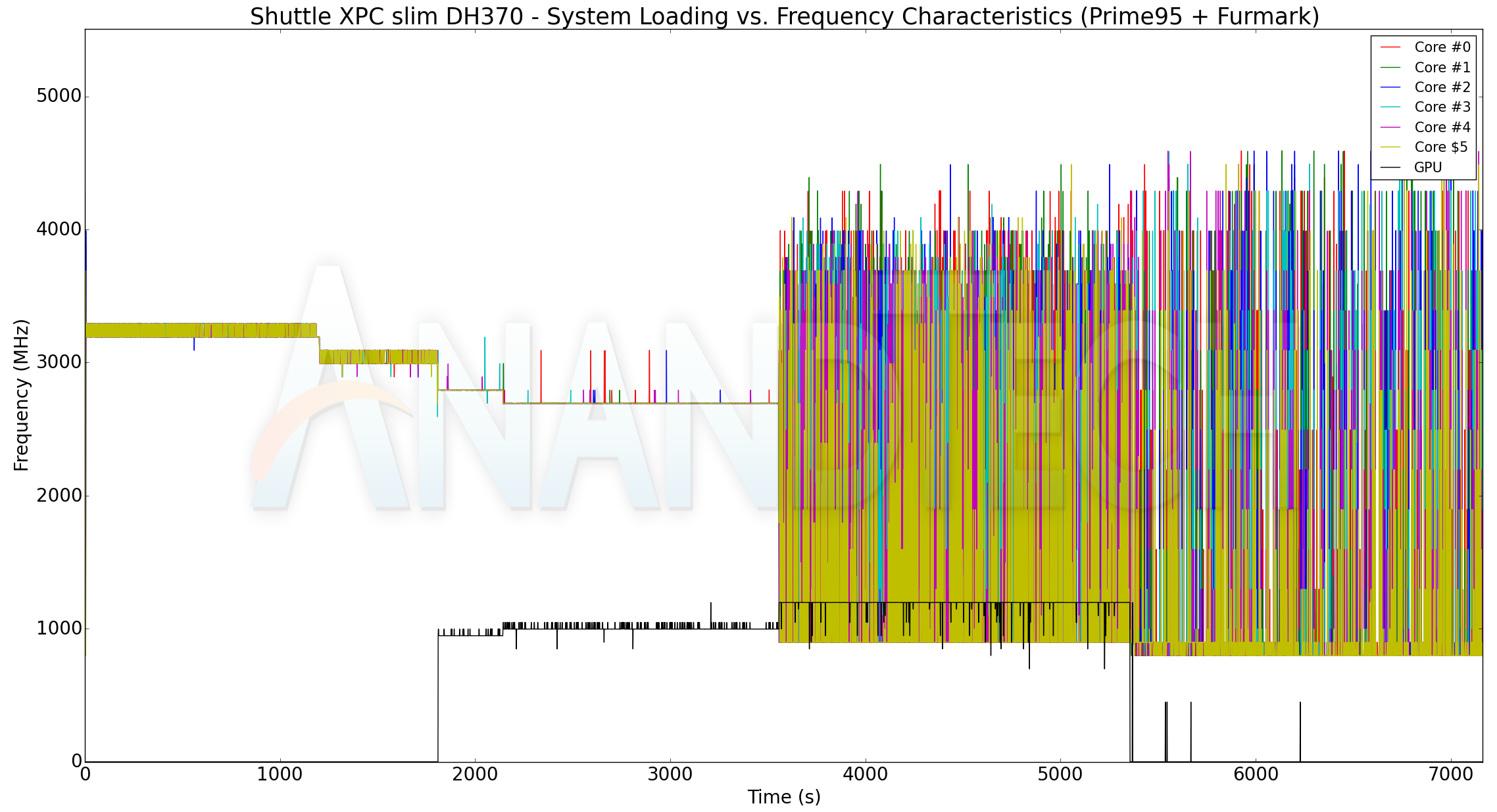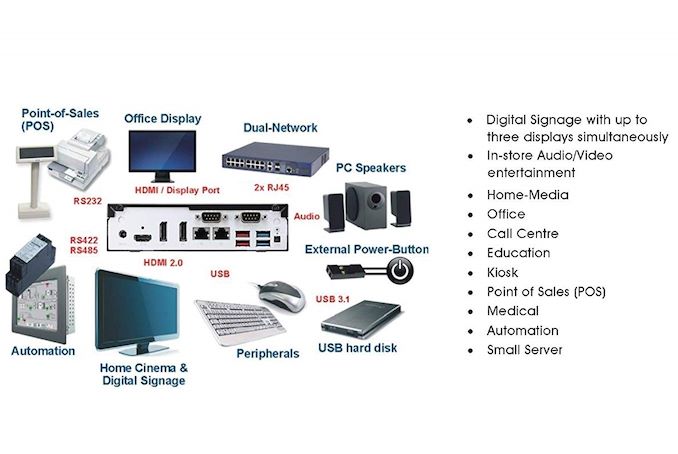Shuttle XPC slim DH370 mini-PC Review: A Compact Digital Signage Powerhouse
by Ganesh T S on May 6, 2019 8:00 AM ESTMiscellaneous Aspects
We have taken a detailed look at the performance of the Shuttle XPC slim DH370 and its suitability for different use-cases in its target markets. Prior to providing some concluding remarks, it is important to get an idea of the power consumption numbers for the system as well as the efficiency of its cooling solution.
Power Consumption
The power consumption at the wall was measured with a 4K display being driven through the HDMI port. In the graphs below, we compare the idle and load power of the Shuttle XPC slim DH370 with other low power PCs evaluated before. For load power consumption, we ran the AIDA64 System Stability Test with various stress components, as well as our custom Prime95 / Furmark loading scripts, and noted the maximum sustained power consumption at the wall.

The system's 10.44W idling power is praiseworthy, given the choice of components. Stressing the 65W TDP processor also makes the system sustain more than 97W at the wall. This is in contrast to the 69W stress number for the 65W TDP Core i3-8100 in the DeskMini 310. The design of the Shuttle XPC slim allows for taking full advantage of the capabilities of the installed processor.
Thermal Performance
Our thermal stress routine starts with the system at idle, followed by four stages of different system loading profiles using the AIDA64 System Stability Test (each of 30 minutes duration). In the first stage, we stress the CPU, caches and RAM. In the second stage, we add the GPU to the above list. In the third stage, we stress the GPU standalone. In the final stage, we stress all the system components (including the disks). Beyond this, we leave the unit idle in order to determine how quickly the various temperatures in the system can come back to normal idling range. The various clocks, temperatures and power consumption numbers for the system during the above routine are presented in the graphs below.
| Shuttle XPC slim DH370 System Loading with the AIDA64 System Stability Test | |||

Despite being rated for operation at 3.2 GHz, the cores spend a majority of their time around the 3 GHz mark in the course of the AIDA stress test. The GPU operates at up to 1.2 GHz. The temperatures always stay south of 85C. The power numbers are more interesting. When all components are getting stressed, the CPU package power is constant around 48W. The interesting aspect to note here is that there is not much variation in the package power for each workload component.
We also run a custom stress test involving Prime95 and Furmark. Starting with Prime95 alone, we add Furmark to the mix after 30 minutes. After another 30 minutes of simultaneous CPU and GPU loading, we terminate the Prime95 process alone and let the GPU run at full throttle. The metrics graphed for the AIDA64 system stability test are also graphed here.
| Shuttle XPC slim DH370 System Loading with Prime95 and Furmark | |||

Our custom test is much more stressful. We see the cores starting out at 3.2 GHz, but, Prime95 makes them reach 90C around 20 minutes into the test. Once the temperature goes above, we see the cores clock down to around 3 GHz. Despite the lower clocks, the package power actually rises from around 50W to 52W. The addition of Furmark to the mix brings down the package power to 45W, and running only Furmark results in a package power dissipation of around 40W. Obviously, the latter two cases are much easier to handle for the cooling solution and we see the temperatures dropping rapidly.
Concluding Remarks
The Shuttle XPC slim DH370 is a compact computing powerhouse. All our benchmark numbers point to that. Shuttle's choice of RAM and SSD for our review configuration actually hold back the numbers a bit. Upgrading the RAM kit (to, say, DDR4-2666) and the SSD (to, say, a PCIe 3.0 x4 NVMe one) would only serve to make the already chart-leading performance better. The choice of external high-speed I/O - in particular, making all four possible USB 3.1 Gen 2 ports come out, is laudable. Dual Intel NICs ought to make the DH370 a good fit for certain networking use-cases.
Shuttle targets various market segments, as shown in their product brief. The DH370 is a very good fit for all of them, but, with caveats. The system can indeed drive three different 4Kp60 displays with HDR simultaneously. However, end-users should note that the usage of this mode may result in performance loss for some of the system workloads. For in-store and home media playback and entertainment, the XPC slim DH370 ticks all the right boxes, but, the fan noise is a definite factor. It is possible that a T-series processor might not stress the cooling system as much. However, the configuration we evaluated was simply too noisy for use as a HTPC. The drawbacks we encountered are not much of a factor for the other targeted applications.
The Shuttle XPC slim DH370 deserves a lot of praise for incorporating a balanced set of features available in the Intel H370 platform into a compact system. The thermal solution (pictured above) does a lot of the heavy lifting to allow the installed processor to perform to its potential. However, its noise profile is also the one trade-off that consumers have to make for the compact size of the system. The $330 barebones price for the system is also reasonable considering the standalone prices for a good H370 motherboard, chassis, and PSU.
Shuttle does have scope for improving the DH370 further - for starters, we would have liked a couple of the USB 3.1 Gen 2 Type-A ports to be Type-C. A Thunderbolt 3 port would have also been nice to have, given that spare PCIe lanes from the PCH as well as the CPU are available. That said, Shuttle's unique features (such as the triple 4K display output) are quite difficult to achieve in a DIY build in this form factor. Based on the results of our evaluation, we recommend the Shuttle XPC slim DH370 for purchase after careful analysis of the expected use-cases.












37 Comments
View All Comments
Guspaz - Wednesday, May 8, 2019 - link
It has to do with the subject of my post. Shuttle sells this as a barebones claiming support for products meeting certain standards. And I’m warning that in the past they have made that claim in a way that is misleading at best and false at worst.Skeptical123 - Wednesday, May 8, 2019 - link
I personal agree with the content of the article in that it's a good box for the use case and price. Except for this one snippet that too many tech reviews have, its good but could be better if it had these expensive rarely used but cool to have features. The reality is this is a custom product for a limited market and regardless of that there is still a lot of competitions in the small form factor pc space around the mid $300 mark. Meaning the company needed to meet a certain price target which I think we can all agree they did at $330. The additional chip required for thunderbolt 3 from intel along costs up to $10s alone. Regardless any additional thunderbolt enclosure would add to the size of the unit which kinda defeats the whole point. And the reality is the people buying these systems know what they're looking for and if they find this product they can defiantly find a similar product that has what they want, say a 10gig Nic integrated in a similar size for a little more $. The company could have chosen to make that product, they did not. That is not a bad thing nor a bad decision.Skeptical123 - Wednesday, May 8, 2019 - link
the quote from the article "Shuttle does have scope for improving the DH370 further - for starters, we would have liked a couple of the USB 3.1 Gen 2 Type-A ports to be Type-C. A Thunderbolt 3 port would have also been nice to have, given that spare PCIe lanes from the PCH as well as the CPU are available."jiangann - Friday, May 10, 2019 - link
wow, very good and detail article. I learned a lot about <a href="https://www.jotrin.com">electronic components</a>.Article layout is very generous and beautifuljiangann - Friday, May 10, 2019 - link
if we want to know more about it, we can have a look at this website https://www.jotrin.com/product/TomWomack - Thursday, May 16, 2019 - link
"It is likely that driving three 4Kp60 displays can take up a significant chunk of the available bandwidth, resulting in the performance loss that we see above"Not that significant - 3840*2160 pixels * 4 bytes per pixel * 3 displays * 60fps is 6GByte/sec and the machine supposedly has 40GByte/sec available.
censtry - Thursday, October 15, 2020 - link
if we want to know more about Censtry electronics , we can have a look at this website https://www.censtry.com/